Lumoa and GPT: How Lumoa Complements GPT for Actionable Insights

Last updated on July 5, 2024
Recently, we did a study at Lumoa on the state of AI in Customer Experience and found out that Artificial Intelligence (AI) has quickly become a core component of improving customer experience (CX), especially in service industries.
The uptake of AI in customer experience is very visible in its use across diverse industries, from manufacturing to telecommunications. We then concluded that AI is changing the way businesses engage with their customers.
Moreover, with AI-driven personalization expected to significantly impact market growth, it’s clear that AI is not just a supplement but a cornerstone of modern customer experience strategies.
On the downside, relying solely on it, such as a known AI technology which is Generative Pre-trained Transformers GPT presents limitations. Challenges such as loss of the nuanced human touch in customer interactions are notable, with a significant portion of users expressing concerns over the technology making content for example feel less authentic. (Master of Code Global).
This article will talk about the comparative effectiveness of using Lumoa and GPT, and a hybrid approach integrating both. By analyzing real feedback across these scenarios, we aim to uncover not only how each performs in isolation but also how they complement each other to deliver superior customer insights and operational excellence.
In This Article:
The Rising Importance of AI in CX
Let’s rewind a bit and check out what’s happening. In our State of AI in CX findings, a notable 70.7% of businesses already utilize AI within their CX strategies, and an overwhelming 86.5% plan to increase their use of AI in the coming years.
This growth is driven by AI’s ability to streamline operations and offer personalized customer interactions, significantly enhancing efficiency and customer satisfaction. For instance, AI-powered chatbots have become crucial in managing customer inquiries, dramatically reducing response times from minutes to mere seconds.
However, integrating AI into business processes presents substantial challenges. Nearly 30% of companies have yet to adopt AI, often due to technical and logistical hurdles or concerns about data security and privacy.
Now let’s talk about GPT. While it plays a role in modern business ecosystems, relying solely on GPT for capturing customer feedback often falls short. GPT’s generalist approach may overlook nuanced insights that are crucial for targeted action. How’s that possible?
Our Approach: Real Feedback, Real Scenarios
Using real customer feedback, we conducted a quick study to uncover the best ways to leverage GPT capabilities with a focus on insights gathering. The study was designed to compare three distinct approaches:
-
Using GPT Alone: This scenario tested the capabilities of Generative Pre-trained Transformers (GPT) in analyzing and categorizing customer feedback without additional support. The goal was to assess how well GPT could handle the data in terms of understanding and insight generation.
-
Using Lumoa Alone: In this setup, we utilized Lumoa’s proprietary AI to analyze the same set of customer feedback. Lumoa’s strengths in data precision and its ability to derive actionable insights from customer data were put to the test, showcasing its effectiveness in a standalone capacity.
-
Integrating Lumoa with GPT: The final scenario combined the data processing power of GPT with the targeted analytical precision of Lumoa. This hybrid approach aimed to demonstrate how the integration of general AI with specialized CX analytics could lead to a richer, more actionable understanding of customer feedback.
Each piece of feedback was processed under these three scenarios to not only evaluate the performance of each tool individually but also to explore how they could complement each other in a real-world application. We carefully selected a diverse range of feedback examples to ensure that our findings would be comprehensive and applicable across various customer interactions.
The 3 Feedback Problem
In our study, we analyzed a dataset of 10,000 public shopping app reviews using the three distinct approaches described earlier. This analysis allowed us to compare the effectiveness of each method in building categories to surface relevant feedback and extract actionable insights that a business could act upon.
To better illustrate our findings, we will focus on three distinct public reviews and observe how they are categorized depending on the method chosen. Below are the public reviews we will use:
- “Easiest to use, works the best with zoom feature I use as a severely sight impaired person. Love how easily it works with the Clubcard feature as well. It’s great.”
- “Totally rubbish, keep asking for valid phone number although I had put the correct number in three times.”
- “Does not give delivery updates as stated.”
The Findings: Clarity, Actionability, and Efficiency
GPT Alone
tl;dr – Almost 65% of our 10,000 app reviews ended up in the category “General”. This is true also for the 3 feedback above, even though they highlight completely different problems.
GPT’s application to topic modeling revealed its limitations in handling nuanced categorization. By testing it against the 3 feedback samples, we discovered that GPT primarily grouped all of it under a ‘General’ category. With 6492 (64.92%) of the total feedback similarly classified, highlighting significant challenges:
-
Clarity: The clarity of GPT’s feedback categorization is notably low. Its approach, which broadly sweeps diverse feedback into a ‘General’ catch-all, lacks the granularity needed to distinguish between different customer issues and concerns effectively.
-
Actionability: The insights derived from GPT’s categorization are critically limited due to its generic grouping. Businesses seeking to address specific issues or enhance particular aspects of the customer data may find this level of generality confusing and adds more manual work, as it provides little concrete direction for targeted actions.
-
Efficiency: While GPT is capable of processing the data, its approach to topic modeling is often less efficient in terms of outcome relevance and operational utility. GPT tends to group a substantial portion of feedback into a broad category. This tendency highlights an inefficiency in achieving the depth of categorization necessary for targeted business strategies.

As you can see from the visual above, each piece of feedback, representing a range of customer experiences and issues, was indiscriminately lumped together which highlighted these samples within the expansive ‘General’ category. Such merging into a singular, vague category shows a significant drawback of using GPT alone for customer feedback analysis.
Without the capability to finely parse and categorize feedback, GPT falls short in providing the depth of insights necessary for targeted business strategies. This highlights the essential need for more sophisticated tools like Lumoa that can complement GPT’s broad capabilities by providing the necessary detail and precision in feedback analysis.
Lumoa Alone
tl;dr – Only 24% of our 10,000 app reviews ended up in the category “General”. The 3 feedback have been assigned to their proper category.
Lumoa, on the other hand, demonstrated its categorization capabilities by specifically assigning feedback to distinct topics like ‘Usability’. (See visual below)
Unlike the broad ‘General’ category prevalent in GPT’s approach, Lumoa’s AI excelled at drilling down into the details of each feedback piece, accurately assigning them to specific and relevant topics. For instance, issues regarding ease-of-use, which GPT had lumped under ‘General’, were identified and grouped by Lumoa into a dedicated ‘Customer experience’ category along with 3290 similar feedback entries.

-
Clarity: The clarity with Lumoa is markedly improved, with specific customer issues being categorized correctly, thereby facilitating a more focused approach to understanding and addressing customer concerns.
-
Actionability: With feedback correctly slotted into specific topics, the potential for businesses to take targeted action skyrockets. For example, the ease-of-use issue feedback can directly inform IT and support teams, enabling them to prioritize and address this specific area of concern.
-
Efficiency: Lumoa enhances operational efficiency by enabling quicker and more effective decision-making. With its more accurate categorization, teams spend less time deciphering feedback and more time implementing solutions that directly address customer needs.
Let’s see what the other two feedback looks like:
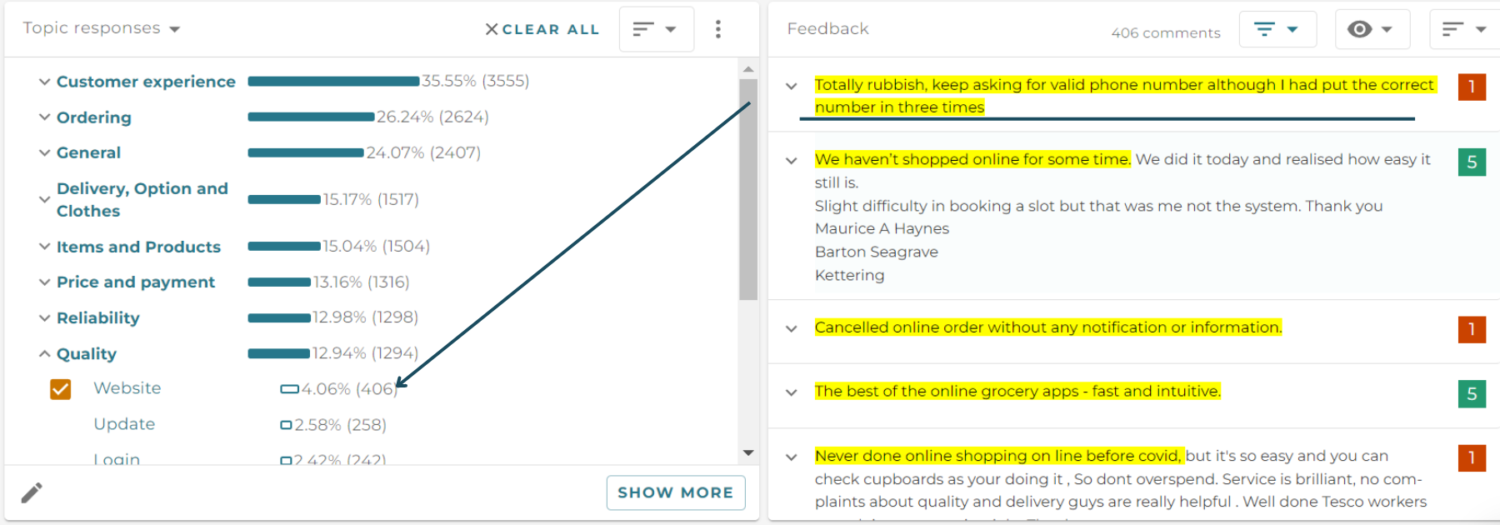
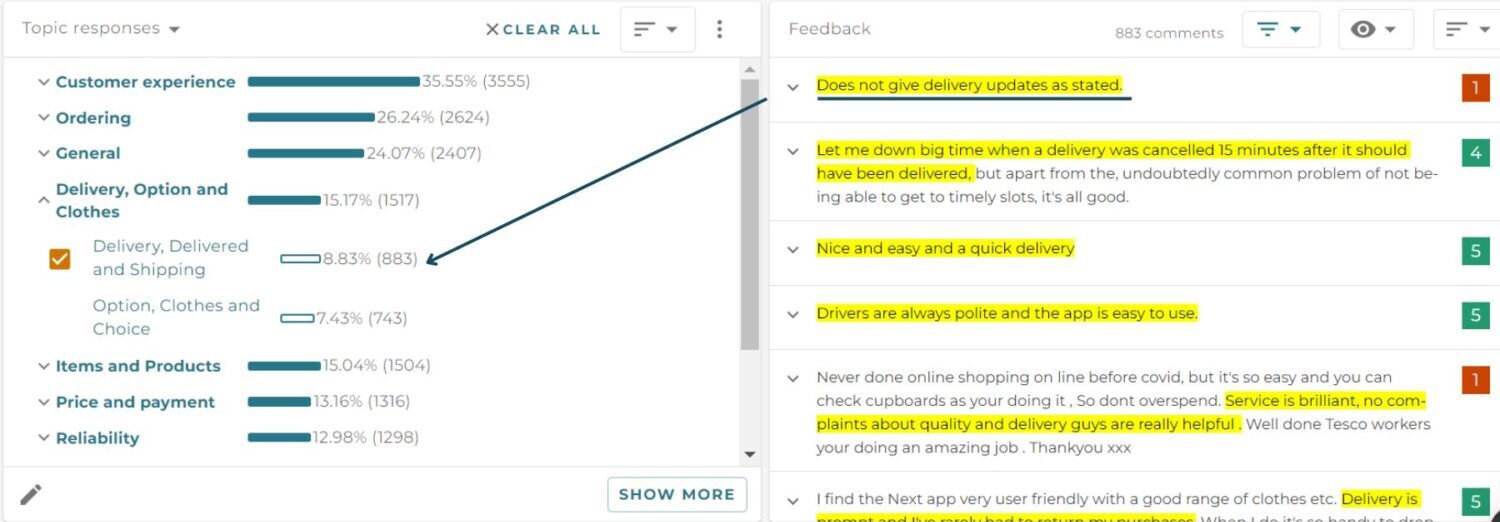
This more accurate categorization by Lumoa offers businesses the clarity and actionability they require for direct and impactful responses to customer feedback. The rest of the feedback samples are also in their own categories. With the ability to classify feedback accurately into distinct topics like ‘Quality’, and ‘Delivery, Option and Clothes’, businesses can now channel their resources more effectively, ensuring that every piece of feedback is utilized to its fullest potential to enhance the customer experience. While this is already impressive enough, we didn’t stop here. Let’s see how well can Lumoa + GPT work together. Let’s check out what they look like when we use both Lumoa plus GPT.
Lumoa and GPT Together
tl;dr – A little less than 24% of our 10,000 app reviews ended up in the category “General”. The 3 feedback are assigned to their own proper category, and the category is easier to understand.
The combined use of GPT and Lumoa AI enriches the customer feedback analysis beyond what is possible when each technology is used separately. While the integration does not significantly reduce the ‘General’ category more than Lumoa alone, it enhances the comprehensibility and relevance of the categorizations. Let’s check out the ‘ease-of-use’ feedback and what it looks like now.
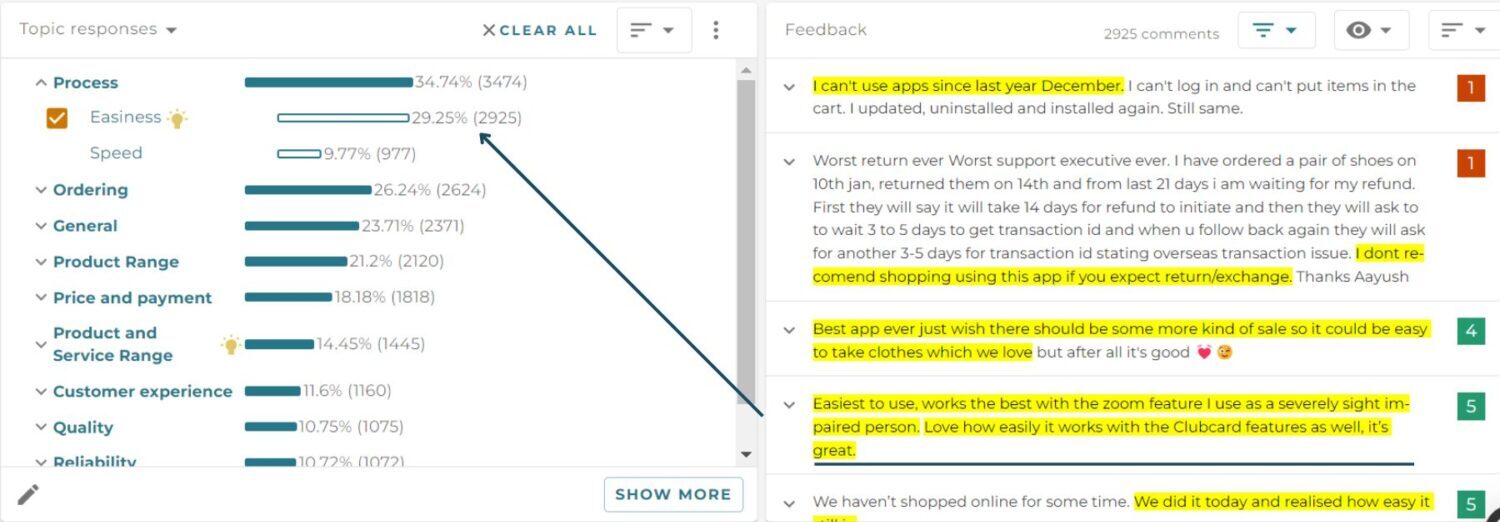
The combination of GPT and Lumoa AI has elevated customer feedback analysis to a new level of sophistication. The feedback that was once relegated to the ‘General’ category from GPT alone, and the ‘customer experience’ category from using Lumoa alone, now finds its place in a well-defined topic that resonates with genuine cx and concerns; in this case – Process topic.
-
Clarity: The integration of GPT’s natural language processing capabilities with Lumoa’s precise analytics significantly enhances clarity. This synergy allows the system to produce topics that are not only accurately categorized but also phrased in ways that are easily understandable, aligning closely with how humans
-
Actionability: By leveraging both technologies, this approach maximizes the actionability of insights. In addition to similar findings from using Lumoa alone, It also enables businesses to swiftly identify and act on specific areas of customer feedback, aligning interventions closely with customer needs and sentiments.
-
Efficiency: While the combination of Lumoa and GPT may involve more complex processing, which can extend the time taken compared to using Lumoa alone, the quality of the output justifies this approach. The system efficiently processes and refines feedback into well-defined categories that significantly aid decision-making processes.
The nuanced understanding of “human language” and the interconnectivity of themes that GPT brings to the table, combined with the precision of Lumoa’s topic modeling, translate into topics that reflect a natural, human-like grasp of the feedback content. Let’s see what the other two feedback look like with this combination.
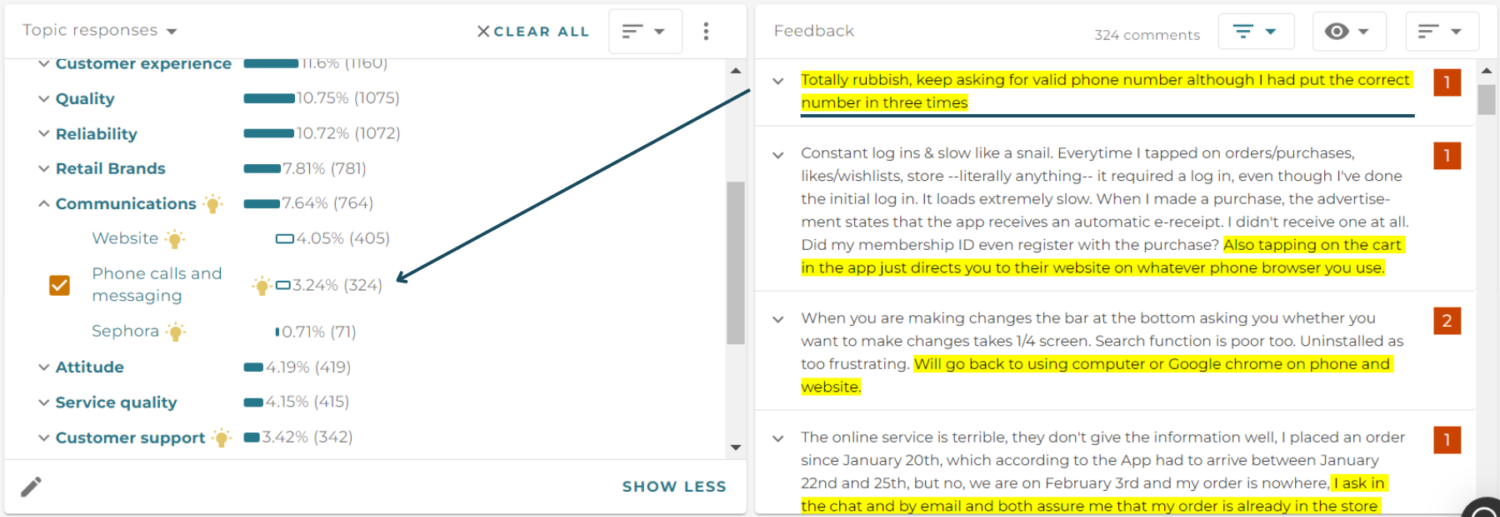
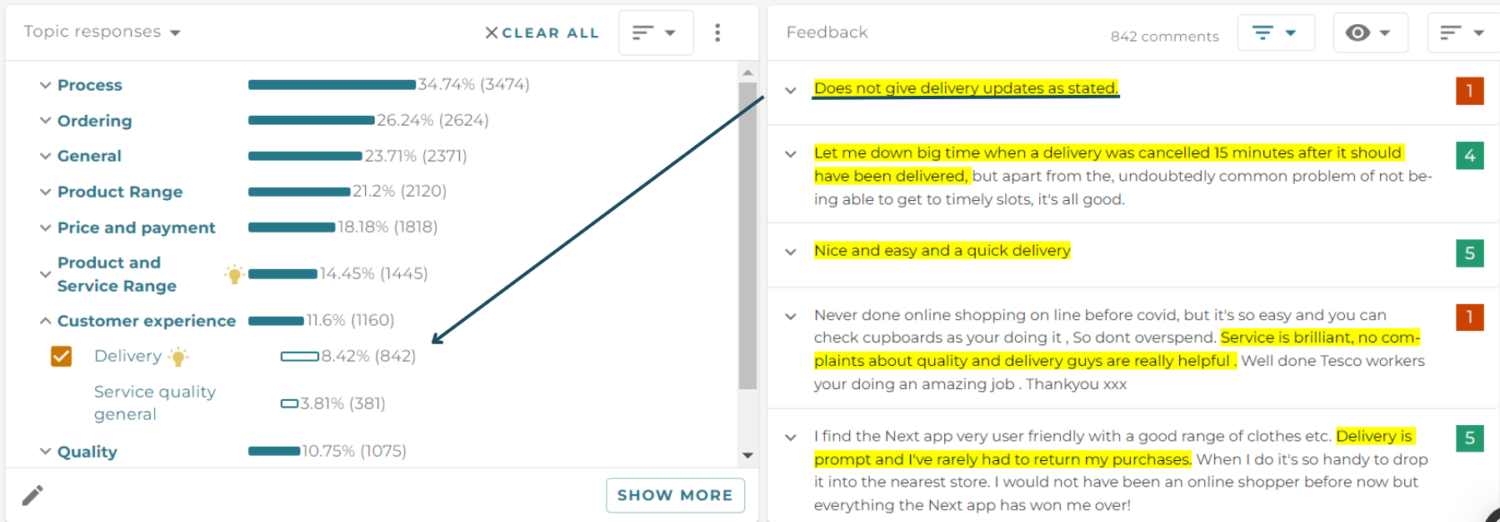
The ‘GPT + Lumoa’ method demonstrates how the fusion of AI and specialized analytics can create a harmonious and potent tool for businesses. This hybrid system doesn’t just process data; it interprets it in a way that aligns closely with human reasoning, setting a new standard for what businesses can expect from AI in customer experience optimization.
This hybrid approach may set a new benchmark for what businesses can expect from AI in optimizing customer experience, making it a compelling choice for those seeking to enhance their analytical capabilities and customer insights.
Addressing Security in AI Feedback Analysis
You can’t ignore the potential risks when implementing AI technologies, especially in sensitive areas like direct customer feedback. Even with its own security measurements and protocols, using GPT directly with customer data presents specific security and privacy challenges that need careful consideration and management.
Potential Risks of Using GPT with Direct Customer Feedback:
-
Data Privacy and Security: GPT processes vast amounts of data, including potentially sensitive customer information. Without proper safeguards, this can lead to data breaches and privacy violations.
-
Bias and Accuracy: GPT models can inadvertently learn and perpetuate biases present in their training data, which could lead to skewed or unfair outcomes when analyzing customer feedback. Perhaps they don’t really train their GPT models with your data, but are you willing to take that risk? Maybe not.
-
Transparency and Control: There is often a lack of transparency in how AI models like GPT generate their conclusions, which can make it difficult for businesses to understand and control how customer feedback is interpreted.
The Advantages of Partnering with a Vendor Like Lumoa: Partnering with a vendor like Lumoa, which is equipped with ISO certifications (ISO 27001) and GDPR compliance, offers substantial benefits in mitigating these risks. Lumoa’s commitment to data protection and ethical AI use provides a robust framework for safely implementing AI in customer feedback analysis.

-
ISO Certifications and GDPR Compliance: Lumoa adheres to international standards and regulations, ensuring that all customer data is handled securely and in compliance with the strictest data protection laws. This adherence helps prevent data breaches and ensures that the privacy of customer information is always maintained.
-
No Model Training on Customer Data: Lumoa does not use direct customer feedback to train its models, which means the data remains untouched and unmanipulated. This reduces the risk of exposing sensitive customer information and ensures that the integrity of the data is maintained.
-
Anonymization of Sensitive Information: Lumoa offers options to anonymize sensitive data, removing personally identifiable information (PII) from customer feedback before it is processed. This not only protects customer privacy but also helps businesses comply with data protection regulations.
Final thoughts
There you have it! Using both GPT and Lumoa, we showed the impact of integrating a powerful AI into customer feedback processes. It not only improves the efficiency and clarity of data processing, but also makes the insights generated highly relevant to specific business needs.
Superior Balance of Comprehensibility and Business Relevance: The combination of Lumoa and GPT provides a balance of comprehensibility and business relevance. Lumoa’s specialized analytics refine the broad capabilities of GPT, ensuring that the data processed is not only comprehensive but also closely aligned with the strategic objectives of the business. This balance is needed for companies aiming to leverage customer feedback effectively, as it allows for a nuanced understanding that is both deep and wide-ranging.
Security and Privacy Benefits: Using a specialized vendor like Lumoa for sensitive data processing offers significant security and privacy benefits. Lumoa’s adherence to ISO standards and GDPR compliance ensures that all customer data is handled with the highest security measures. Furthermore, Lumoa’s commitment to not training its models on customer data and providing options for anonymizing sensitive information ensures that customer privacy is maintained at all times. These practices are essential in the digital age, where data breaches and privacy violations can severely impact a company’s reputation and customer trust almost on a daily basis.
The Importance of Ethical AI Use: Companies are increasingly integrating AI into their operations, so ethical AI usage becomes increasingly important. The combination of using Lumoa with GPT serves as a model for how AI can be used responsibly in customer experience strategies. Transparency, data integrity, and privacy can help companies avoid the pitfalls associated with AI technologies.
For businesses looking to enhance their customer experience through AI, the insights from this article provide a clear message. The integration of GPT with specialized CX analytics like Lumoa offers a powerful combination for turning raw data into actionable insights. We invite businesses to consider this hybrid approach not just as a technological upgrade but as a strategic necessity for staying competitive in a customer-centric market.
It’s both exciting and challenging to integrate AI into customer feedback analysis. But, with the right tools and approaches, businesses can navigate this path successfully, leading to enhanced customer satisfaction and business growth. Interested in learning more about Lumoa’s capabilities? Book a demo now and we’ll help you achieve your goals and KPIs
